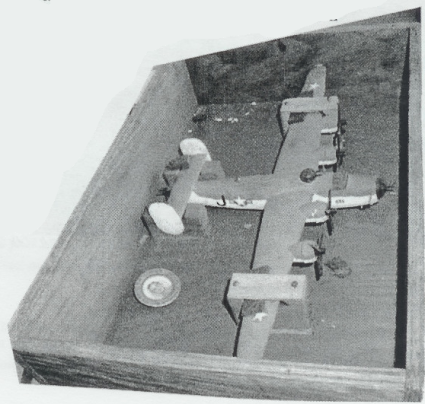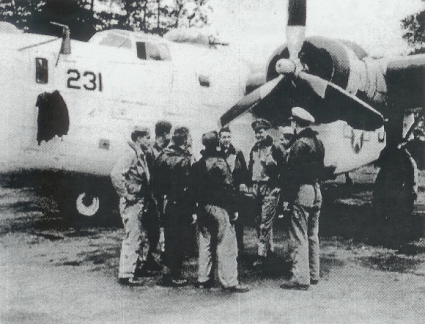A WWII English Love Story
June 6th, 2010 by xformed
In rememberance of D-Day today, a story about three men:Â An American pilot, an Englishman, and the pilot’s son.
I first met Doug Kirkland in Oct/Nov 1976, while attending Communications Officer School in Newport, RI. We never really talked, he being a LT, seasoned aviator and me merely an Ensign with no permanent ship assignments in my record. In Oct, 1989, as I emceed the Change of Command, a face in the guest seats kept attracting my attention. It was Doug. At the reception, we both realized we knew each other, but it took about 30 minutes of the “were you ever stationed at…” conversation to finally get us to the point were we figured we had been in Newport for school at the same time, and other than that, our paths had not crossed professionally or otherwise since then. Fast forward to 2009, when I began going to the every other Saturday breakfasts with a group of local vets…there was Doug again, and one morning, he told me this story and has been kind enough to share it, particularly with the hope the story will maybe connect a few more people who are involved in this story.
Here’s my request:Â Pass this story along, please.

A Model of a US Navy PB4Y-l Bureau # 231
English Love Story – Why FAW-7 Loves the people In tbe Devon countryside
This was written by Captain Douglas I. Kirkland ( Delta Air Lines) of Reddington Beach, FL about his father.
My father, Lieutenant Commander Lawrence A. Kirkland, Jr. ( deceased 1990) was a Navy pilot in World War II. Dad graduated Naval Pilot Training in class 2B41J at the Naval Air Station Jacksonville, Florida early 1941. During the early part of the war he flew PBY aircraft first in the Pacific Asiatic and later in North Africa. When VPB-U4 was commissioned, Dad was assigned as Plane Commander and according to bis squadronmates, he was one of the “war weary”, well seasoned veterans at the squadrons beginning in August of 1943.
VPB-114 deployed to Dunkeswell Abbey Airfield Near Exeter in Devon, England and this history is well documented at the museum.
To cope with the rigors and stress of the 41 missions Dad dew from Dunkeswell in PB4Y-1 aircraft, be would take a shotgun and hunt on farmland in the Honiton to Broadhembury area just south of Dunkeswell Airfield. Â He would then take his fresh kill to The inn at Broadhembury (which still has a great thatched roof’ pub), and have it cooked, dine with his favorite libation in hand, and finally relax a bit.
The Frost Family farm near Broadhembury was a favorite hunting place of Dads, and the descendant of Mr. and Mrs. Robert Frost still lives on the farm today (John and Jean ( Frost) Barker) Incidentally, both Jean and John Barker remembered my father when I visited them in December of 1998. The Barker’s mentioned that lots of the men stationed at Dunkeswell hunted their farmland and one man in particular liked to hunt rabbits with a Thompson submachine gun (guess the ammunition and the rabbits were plentiful then)!
According to Dad, one day white relaxing at the Inn at Broadhembury, be met a man named Theo Church from Ex-Axminister, a carpenter by trade. Thea Church was making aircraft parts on jigs in his shop for the war effort. In conversation, Dad discovered that Theo Church had never been in an airplane, even though he was making aircraft parts! Dad invited Theo to go on a training flight from Dunkeswell, and he provided Theo with a flight suit and the necessary instructions for the flight. All went off with out a hitch, and several months after the flight, Theo Church came to Dad and presented this hand made, wooden model of a P84Y-1 ship 8ureau #231.
Dad asked Theo to keep the model for the duration of the war, and then ship it to me, because of the the “uncertainties” in his schedule and his longevity. Dad later gave the model to me and after he died, I found a scrapbook from WW II with pictures of the actual plane # 231 in a revetment at Broadhembury. The box, the stamps, the model, everything you see is just as be received it from Theo Church after the war. This model and its history have always symbolized for me, the spirit of cooperation and combined efforts of our countries in defeating our enemies. Truly, the men and women who served our Countries in WW II deserve our eternal gratitude.
For the most part, they were ordinary citizens who performed extraordinarily. When the war ended, they returned to their families and civilian life and built the better World we now enjoy.
I welcome any additions or input from this word of mouth story about my father.
CDR Douglas I. Kirkland, USNR-R (Ret)
16500 Gulf Blvd. Unit 455
North Redington Beach, FL 33708
850-960-8866 cell
727-320-0012 home
[email protected]

Captain Meyer Minchen of Houston, Tx., offers the following information about # 231. Jack McGarry ( Plane Captain) and Jim Baird AMM in Crew 11 were prefiighting the plane for a patrol, and were not in the picture at left.  However they did help in identifying the crew members of #231 in VB-114. Left to right: John Paul Woods, Harold Coffin, Cliff Halls, Larry Kirkland, More Slouch, Don Burns, Oren W. Clark (PCP), Meyer Minchen, Ed E. .Elmwood.
Category: Air Force, Army, History, INternational Relations, Leadership, Maritime Matters, Military, Military History, Navy | 1 Comment »


![Reblog this post [with Zemanta]](http://img.zemanta.com/reblog_e.png?x-id=bad94cc4-5669-42f2-883b-7eb280c09745)